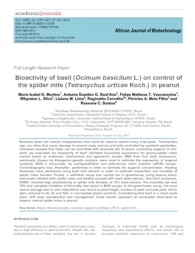Bioactivity of basil (Ocimum basicilum L.) on control of the spider mite (Tetranychus urticae Koch.) in peanut.
Bioactivity of basil (Ocimum basicilum L.) on control of the spider mite (Tetranychus urticae Koch.) in peanut.
Autoria: MARTINS, M. I. G.; SANT'ANA, A. E. G.; VASCONCELOS, F. M. T.; SILVA, W. L.; LIMA, L. M. de; CARVALHO, R.; MELO FILHO, P. A.; SANTOS, R. C. dos
Resumo: Essential plant oils contain biopesticides that could be used to control many crop pests. Tetranychus spp. are mites that cause damage to several crops and are primarily controlled by synthetic pesticides. Literature showed that mites can be controlled with essential oils of plants containing eugenol. In this work, we evaluated the bioactivity of basil (Ocimum basicilum) accessions for peanut-spider mites control based on molecular, biochemical and agronomic assays. RNA from four basil accessions, previously chosen by divergence genetic analysis, were used to estimate the expression of eugenol synthase (EGS I) transcripts, by semiquantitative and polymerase chain reaction (qPCR) assays. Chromatography was, thereafter, performed in order to estimate the eugenol concentration. Feeding bioassays were performed using basil leaf extracts in order to estimate oviposition and mortality of spider mites females. Finally, a validation assay was carried out in greenhouse, using peanut plants previously infested with spider mites and weekly sprayed with basil water-extract. One basil accession, OVRS, revealed high phytotoxicity to spider mite females, at 15% water-extract. The mortality rate was 75% and complete inhibition of fecundity was found in BOD assays. In the greenhouse assay, the most severe damage due to mite infestations was found to plant height, number of pods and pod yield, which were reduced to 28, 53 and 52% in non-treated plants (control). Considering that basil is a short-cycle plant, with easy reproduction and management, these results represent an accessible alternative to organic control spider mites in peanut.
Ano de publicação: 2016
Tipo de publicação: Artigo de periódico
Unidade: Embrapa Algodão
Palavras-chave: Amendoim, Aranha ácaro, Chromatography, Cromatografia, Eugenol, Ocimum Basicilum L, Peanuts, Spider mites, Tetranychus urticae
Observações
1 - Por padrão são exibidas publicações dos últimos 20 anos. Para encontrar publicações mais antigas, configure o filtro ano de publicação, colocando o ano a partir do qual você deseja encontrar publicações. O filtro está na coluna da esquerda na busca acima.
2 - Para ler algumas publicações da Embrapa (apenas as que estão em formato ePub), é necessário ter, no celular ou computador, um desses softwares gratuitos. Sistemas Android: Google Play Livros; IOS: iBooks; Windows e Linux: software Calibre.
Acesse outras publicações
Acesse a Base de Dados da Pesquisa Agropecuária (BDPA) para consultar o acervo completo das bibliotecas da Embrapa.

